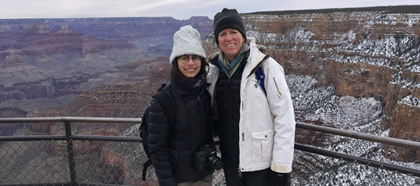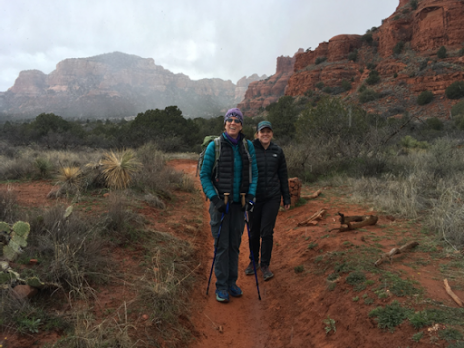At the end of January, Winnipeg was under an extreme cold warning with temperatures dipping to -47°C with the wind-chill. I was ecstatic to escape the bitter cold and travel to warm, sunny, Arizona. Stepping off the plane in Phoenix was like heaven, a mere 13°C felt like beach weather. The trip from Phoenix to Flagstaff was beautiful. Seeing cacti as the sun went down over the mountains was everything that I imagined Arizona to be. By the time that I arrived in Flagstaff, it was dark and a little chilly. When I woke up the next morning, I got dressed, packed my bags for the day, and headed off to Northern Arizona University. You can imagine my surprise when I opened the door to see a fresh blanket of snow!
Between February 3rd and the 17th, I participated in a laboratory exchange at Northern Arizona University under the supervision of Dr. Loren Buck and Dr. Kathleen Hunt. The main objectives of the laboratory exchange were to 1) receive training in hormone analyses, 2) measure corticosterone from baleen plates collected from 9 bowhead whales, 3) network and collaborate with researchers from Northern Arizona University, and 4) publish peer-reviewed journal articles focused on the physiology of bowhead whales.
Baleen is a filter-feeding apparatus that is present in all mysticete whale species and grows continuously over the course of an individual’s lifetime. Hormones and stable isotopes are incorporated in to baleen as it grows, allowing researchers to examine foraging and endocrine patterns over the length of a plate, which in bowhead whales may represent 10-20 years. The goal of this project, led by Dr. Kathleen Hunt and Dr. Cory Matthews, was to assess reproduction of bowhead whales by measuring corticosterone profiles along baleen plates, in combination with previously analyzed testosterone and stable isotope profiles.
On my first day, Kathleen introduced me to everyone working in the lab and then we got started on setting up our schedule for the week. During the first week, Kathleen showed me how to properly run an enzyme immunoassay and together, we processed over 1000 samples. I also had the opportunity to present my research to Loren’s lab, which was then followed by dinner at a local restaurant. Kathleen and I finished a busy week in the lab with a lovely drive to the Grand Canyon, which was definitely a highlight of the trip!

During my second week, Kathleen showed me how to process our newly assayed data. I ran preliminary analyses, started compiling data, and packed up samples to ship back to Winnipeg so that I could assay them all again for triiodothyronine (T3), which is a metabolic hormone. We finished another busy week with a lab trip to Sedona, followed by a lovely dinner!

When applying for the RCN laboratory exchange, I hoped to receive training from experts in the field, but the experience was much more than that. Not only did I receive training, but I also met and networked with graduate students from all over the world and learned how using a physiological approach can help us answer a range of questions. Through this experience, we also formed strong multi-institutional, multinational networks between researchers from the University of Manitoba, Fisheries and Oceans Canada, and Northern Arizona University. Since returning home, our network has submitted abstracts to two international conferences and will soon be working on a peer-reviewed journal article.
I would like to thank Dr. Loren Buck for hosting me in his lab, Dr. Kathleen Hunt for the training and mentorship, Dr. Cory Matthews for facilitating this exchange, and to all lab members that took the time to talk to me about their work. I would also like to thank the RCN g2p2pop committee for this amazing opportunity. It was such a great experience and I encourage anyone interested to apply!